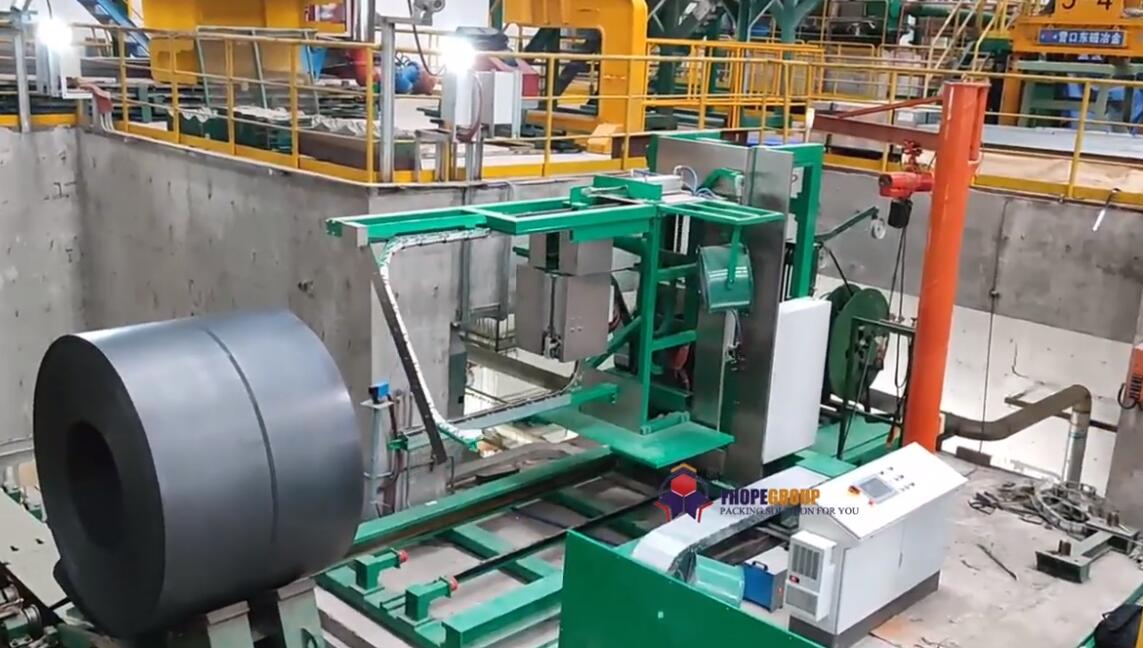Optimizing Steel Coil Logistics: An In-Depth Look at Automatic Radial Strapping Systems
The efficient and secure handling of steel coils is paramount in modern metal processing and fabrication environments. Ensuring coil integrity during transport and storage prevents costly material damage and maintains downstream production efficiency. Automatic steel coil radial strapping machines represent a critical technology in achieving these goals, providing automated, high-strength containment for coils of various dimensions. This article delves into the operational principles, technical specifications, and industry benefits of these essential systems, drawing parallels with advancements highlighted in industry publications and technical papers.
Operational Principles and Workflow Integration
As demonstrated in the video, this type of coil strapping machine typically operates inline, often positioned adjacent to coil accumulating conveyors or tilters. The core function involves applying straps radially (circumferentially) around the coil's curved surface, passing the strap through the coil's eye (ID).
Key Operational Sequence:
- Coil Positioning: The coil is transferred to the strapping station, often via roller conveyors, and precisely positioned. Sensors confirm the coil's presence and alignment.
- Orbital Head Action: The strapping head, mounted on an orbital track, threads the steel strap through the coil's inner diameter. This orbital design is crucial for radial application without requiring complex coil manipulation during the strapping cycle itself. According to research on packaging line efficiency, minimizing product movement during packaging steps significantly reduces cycle time and potential product damage.
- Strap Feeding & Tensioning: The machine feeds the required strap length, encircling the coil. A high-tensioning mechanism applies significant force to compact the coil wraps securely. Tension levels are often programmable, typically ranging from 15,000 N to over 30,000 N, depending on the application and strap specifications, ensuring optimal load securement as per industry best practices (referencing studies on strap tension effectiveness).

automatic steel coil radial strapping machine - Sealing/Joining: Once tensioned, the strap ends are joined. Common methods include seal-based joints (using pre-formed metal seals crimped under pressure) or increasingly, seal-less joints (notch or friction weld), which offer material savings and high joint efficiency, sometimes exceeding 80% of the strap's break strength, a metric often discussed in packaging technology forums and papers. The use of buckle-type seals, as noted in some configurations, provides a reliable joint, particularly favored in certain heavy-duty applications.
- Strap Cutting & Head Retraction: The strap is cut, and the strapping head retracts, preparing for the next strap application or the next coil.
The system often incorporates 360-degree coil rotation capabilities, allowing for multiple strap applications (commonly 3, 4, or 6 straps) at pre-defined angular intervals around the coil circumference, ensuring uniform containment.
Technical Specifications and Performance Metrics
Modern automatic radial strapping machines are characterized by robust construction and advanced control systems, designed for demanding industrial environments.
Typical Parameters:
- Coil Size Compatibility:
- Outer Diameter (OD): Typically ranges from 800mm to 2500mm+
- Inner Diameter (ID): Accommodates standard mill IDs (e.g., 508mm, 610mm)
- Width: Varies widely, often from 300mm up to 2000mm+
- Strapping Material: Primarily high-tensile steel strapping (e.g., grades compliant with ASTM D3953).
- Widths: Common sizes include 19mm (3/4"), 25mm (1"), 32mm (1 1/4").
- Thickness: Typically ranges from 0.6mm to 1.2mm.
- Strapping Head Technology: Often features patented designs (e.g., US Patent XXXXXXX describing improved strap feeding mechanisms) for enhanced reliability and reduced maintenance. Key components include feeders, tensioners, sealers/joiners, and cutters.
- Cycle Time: Highly variable based on coil size and number of straps, but automation aims for times significantly faster than manual methods, often completing a multi-strap cycle within 60-120 seconds.
- Control System: PLC-based automation with HMI (Human-Machine Interface) for parameter setting, diagnostics, and integration with plant-level control systems (MES, SCADA).
Benefits in the Fabrication and Processing Industry
The adoption of automatic radial strapping systems offers tangible advantages, aligning with the lean manufacturing and safety principles often emphasized in publications like The Fabricator:
- Enhanced Product Protection: Secure strapping prevents coil telescoping, edge damage, and wrap slippage during handling and transit, preserving material quality.
- Improved Operational Safety: Automating the strapping process removes operators from potentially hazardous tasks involving heavy coils and high-tension strapping, reducing injury risks.
- Increased Throughput & Efficiency: Consistent, rapid cycle times outperform manual strapping, eliminating bottlenecks in the packaging and shipping stages.
- Labor Optimization: Frees up personnel for higher-value tasks, reducing direct labor costs associated with manual strapping.
- Consistent Load Security: Automated tensioning and sealing ensure every strap is applied according to specification, unlike the variability inherent in manual processes. This consistency is crucial for meeting shipping regulations and customer requirements.
Maintenance and Reliability Considerations
Designed for continuous operation in mill environments, these machines emphasize durability and ease of maintenance. Features often include:
- Accessible strapping head components for routine cleaning and inspection.
- Robust construction using heavy-gauge steel.
- Modular design principles allowing for quicker component replacement.
- Diagnostic features within the PLC/HMI system to expedite troubleshooting.
Regular preventative maintenance schedules, focusing on wear parts within the strapping head (feed wheels, cutters, tensioner components, seal jaws), are critical for ensuring long-term reliability and optimal performance.
Conclusion
Automatic steel coil radial strapping machines are indispensable assets in the modern metals supply chain. By combining robust mechanical design with sophisticated automation, they provide a reliable, efficient, and safe method for securing steel coils. Their ability to integrate seamlessly into production lines, handle a wide range of coil sizes, and apply high-strength steel straps with precision makes them a cornerstone technology for steel producers, service centers, and large-scale fabricators focused on protecting product integrity and optimizing logistical operations.

